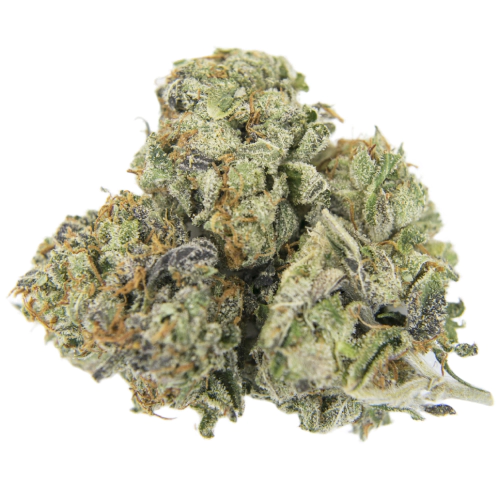THC 18 - 20%
CBD 0.63 - 0.9%
Effect Sleepy
Flavor Berry
8.5 - 11.5%
0.02 - 0.23%
0.32 - 1.11%
Sage, Cheese
Giggly
Purple Fanta was derived from the Purple strain. This weed is a pure Indica strain containing low amounts of THC - 8.5 - 11.5%, and low amounts of CBD compounds - 0.02 - 0.23%. The range of terpenes isn’t quite rich as well. Besides, the volumes of components aren’t equal:
The Purple Fanta strain is a green plant with bright purple hues. Although linalool is a rare terpene for cannabis, it’s a dominant component for the terpene profile of this weed strain. This means it determines the flavors. The vast majority of users report they feel sage flavors.
We dare not say that you will experience the effects we are going to describe below. There are many factors that might impact this experience, we just want to provide you with the most common effects.
As we have figured out from many reviews by those who have smoked or dabbed Purple Fanta, the dominant effects are as follows:
When exploring strains, make sure you know about possible side effects. Purple Fanta isn’t a strong weed, so, naturally, side effects won’t be severe even if they occur to you:
| THC | Tetrahydrocannabinol, or THC, is a major cannabis chemical compound. It is a psychoactive element that stimulates dopamine release and induces euphoria or happiness. THC-rich strains may be helpful with such conditions as lack of appetite, chronic pains , etc. It is considered to be the primary active marijuana component. | 8.5 - 11.5% |
| CBD | Cannabidiol, or CBD, is a major compound in cannabis, which is non-psychoactive. It is also proved to counteract the side effects of the second major component THC. CBD is widely used for medicinal purposes in rubs, oils and so on. It is helpful in muscle pain cases, may treat arthritis and migraines. Even Greeks used it against pain, while Queen Victoria applied it to get rid of menstrual cramps. | 0.02 - 0.23% |
| CBC | Cannabichromene, or CBC, is a minor cannabinoid, meaning that its quantity in cannabis is quite little. Though it has the same origin as CBD and THC, it is different in functions. Without any psychoactive effects, it is an efficient cannabis compound in combating acne and depression. CBC produces analgesic, antibacterial and anti-inflammatory effects. | 0.14 - 0.54% |
| CBG | Cannabigerol, or CBG, is one of the minor cannabis compounds in adult plants. On the other hand, young ones contain a lot of this antibacterial and anti-inflammatory component. During the growth, CBG is converted into different cannabinoids, mostly THC and CBD. The compound itself increases appetite and decreases eye pressure. | 0.32 - 1.11% |
| CBN | Cannabinol, or CBN, is a trace element in cannabis that is considered to be mildly psychoactive. It appears from oxidation THC, exposed to light and heat. CBN is mostly contained in old cannabis and in traditional hashish. It is effective against insomnia, bacterial infections and appetite loss. | 0.04 - 0.18% |
| THCV | Tetrahydrocannabivarin, or THC-V, is a compound contained in cannabis in trace amounts. Even though it is close to THC molecularly, it is different in effects. This compound may be psychoactive only in large amounts. THC-V reduces blood sugar, controls appetite, stimulates bone growth, etc. African Sativa strains are the richest in THC-V. | 0.27 - 0.87% |
| Pinene | Pinene is one of the most widespread terpenes in nature, found in pine trees, basil, nutmeg, parsley, and rosemary. Cannabis containing terpene (alpha-pinene or α-pinene) boasts a strong pine scent. Pinene is responsible for anti-inflammatory, pain-relieving, and anti-anxiety effects. | 0.33% |
| Myrcene | Myrcene (also known as β-myrcene) is one of the most common terpenes found in cannabis, representing more than 20% of the modern marijuana terpene profile. Myrcene has a distinct earthy, musky flavor, resembling cloves. It is responsible for calming and soothing effects of weed. Myrcene is also found in hops, thyme, mango, lemongrass, guava melon. | 0.07% |
| Linalool | Linalool (also known as beta linalool, linalyl alcohol, linaloyl oxide, and p-linalool) is one of the rarest terpenes found in cannabis, mostly in small quantities. Linalool is known for its spicy and lavender aroma, bringing relaxation and calming effects. It is also said to provide anti-inflammatory and analgesic properties that can be useful for athletes. | 0.53% |
| Sabinene | Sabinene is a terpene with a peppery, spicy, citrusy, and piney aroma, presented in Norway spruce, Holm oak trees, black pepper, cardamom, and carrot seeds. Found in cannabis in small quantities. Allegedly, sabinene has anti-inflammatory and antimicrobial properties. | 0.07% |
| Total terpenes content | 1.00% |
THC 18 - 20%
CBD 0.63 - 0.9%
Effect Sleepy
Flavor Berry
THC 8.25 - 10.25%
CBD 0 - 0.03%
Effect Giggly
Flavor Pungent
THC 23 - 24%
CBD 0.34 - 0.54%
Effect Giggly
Flavor Spicyherbal
THC 1 - 5%
CBD 25 - 25.23%
Effect Energetic
Flavor Lemon
THC 13 - 17%
CBD 0.29 - 0.26%
Effect Tingly
Flavor Menthol
THC 17.33 - 20.33%
CBD 0.41 - 0.63%
Effect Giggly
Flavor Sweet
THC 18 - 20%
CBD 0.65 - 0.82%
Effect Happy
Flavor Pineapple
THC 20 - 23.17%
CBD 0.56 - 1.16%
Effect Happy
Flavor Orange

THC 16.6 - 20.2%
CBD 0.29 - 0.65%
Effect Happy
Flavor Blueberry
THC 13 - 17%
CBD 1.91 - 3.62%
Effect Giggly
Flavor Sweet
Be the first and share your opinion
Write a Review